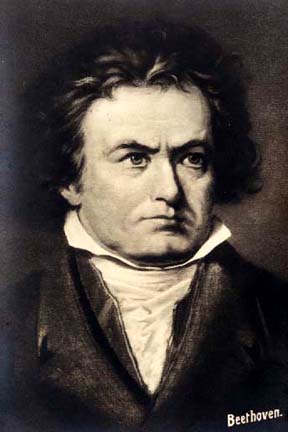
FILE PHOTO
The Honolulu Symphony, led by maestro Samuel Wong with the chorus being led by Karen Kennedy, will perform Beethoven's Ninth at 7:30 p.m. Tuesday.
Music’s ubiquity
a thing of joy
Celebrate the New Year in style with Beethoven's legendary Ninth Symphony, a masterpiece that's become an anthem of universal brotherhood. If you don't remember the tune, you can hear pieces of it just about everywhere, from movies like "Die Hard" and "A Clockwork Orange," to an episode of "Buffy the Vampire Slayer," to a popular cell phone ring. But, nothing can compare to a live performance and the more than 130 voices of the Honolulu Symphony Chorus as they sing "Freude, schoner Gotterfunken!" That's German for "joy, beauteous spark of divinity," in a triumphant expression of mankind.
The Honolulu Symphony, led by maestro Samuel Wong, with the chorus led by Karen Kennedy, will ring in the New Year with this renowned symphony, on Tuesday. The Chorus, fresh from a performance at New York's Carnegie Hall, is gearing up to dazzle you with uplifting festive jubilation. We'll be joined by four acclaimed soloists who hail from Hawaii: soprano Lea Woods Friedman, tenor Les Ceballos, contralto Lorna Sterling Mount and baritone John Mount.
THE NINTH Symphony has a long and illustrious history that continues to grow. It's the European Union's anthem. Student protesters played it at Tiananmen Square. It consistently tops the bill when a new concert hall is dedicated. The final manuscript for the work recently sold at auction for $3.47 million. Musicians from both sides of the Iron Curtain performed it when the Berlin Wall came crashing down in 1989. Back in 1956, East and West Germany selected it as their anthem for a joint team of Olympic athletes. And, the people of Japan have embraced this work to such extent that it's become a Holiday institution. "Daiku," or simply "Nine," is performed more than 60 times each December.
Beethoven's Ninth
The Honolulu Symphony and Honolulu Symphony Chorus are joined by the Honolulu Brass Ensemble plus soloists Lea Woods Friedman, Lorna Sterling Mount, Les Ceballos and John MountWhere: Blaisdell Concert Hall
When: 7:30 p.m. Tuesday Tickets: $28, $38, $53, $63 and $73 each
Call: 792-2000 or Ticketmaster at (877) 750-4400
Program: Beethoven's Symphony No. 9, Wagner's "Gathering of the Armies" from Lohengrin, and Handel's "Music for the Royal Fireworks"
The text to the Ninth Symphony's Ode to Joy comes from "An die Freude" or "To Joy," a poem written by German playwright Friedrich Schiller. First published in the late 1700s, this ardent expression about humanity secured Beethoven's lasting interest. However, 30 years and eight symphonies went by before he felt confident enough to put the poem to music.
Composed late in Beethoven's life in 1823, the Ode to Joy resonates magnificently in our hearts. It symbolizes the deliverance from humankind's hardships and challenges -- the agony of doubt, questions of faith and the search for love -- the Ode has it all.
The movements that precede the Ode to Joy lay the perfect groundwork to its spectacular conclusion. The mysterious and turbulent opening can be compared to the void of nothingness before the creation of the universe. In musical terms, this effect is achieved by playing two musical notes separated by an open fifth. If you can't picture it, type a Q and T on your keyboard. You'd call it a fifth in music.
Nervous tension pervades the first movement, but it's somewhat relieved by the ensuing furious Scherzo. "Scherzo" literally means "joke" in Italian, but a farce might be a better description, with our timpani (drums) being the loudest of comedians.
The intimacy of the slow movement clashes with the finale's electrifying opening. Once the dust settles, celli (plural for cello) and basses take over with a strong statement, or recitative, and introduce the famous melody. There's no singing just yet, simply a serene atmosphere that gradually builds. Suddenly, a clash disrupts the music. This clearly annoys the baritone soloist who rises in fury and sings: "O friends, not these sounds! Rather let us sing more pleasant ones!" Stirred up by this declaration, all voices from the choir and soloists join in.
WHAT FOLLOWS is an incredible culmination of powerful music that takes you right to the finish line. There's even a Turkish march mixed in, so called for its use of cymbals, and bass drums and triangle. Perhaps the Turkish march was intended as a musical gesture to bridge cultural differences? We may never know, but rest assured you'll be caught up in this spectacular, musical whirlwind.
Amazingly, Beethoven suffered from total deafness when he wrote the Ninth. Legend has it that at the 1824 premiere, he was totally unaware of the enthusiastic response because he couldn't see the audience from his seat. While this is a credible story, I prefer to think that he was unable to react because he was overwhelmed by the feeling of transcendence that the live performance of his work created.
* * *Congratulations to our Holidays Pops Trivia winner, Gail, who answered our question from Dec. 8 correctly. The melody for "Hark the Herald Angels Sing" came from a hymnal composed by Felix Mendelssohn: Specifically Festgesang.
Happy New Year from all of us at the Honolulu Symphony!
Ignace "Iggy" Jang is the Honolulu Symphony's concertmaster. His column generally appears Mondays prior to each concert of the season to illuminate works to be performed. E-mail comments and questions to Jang at suggestions@honolulysymphony.com
Click for online
calendars and events.

